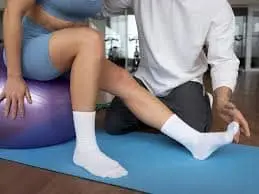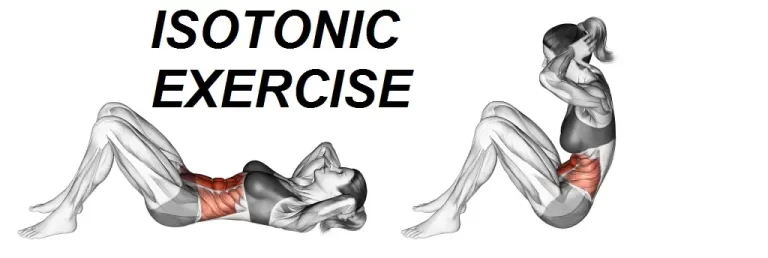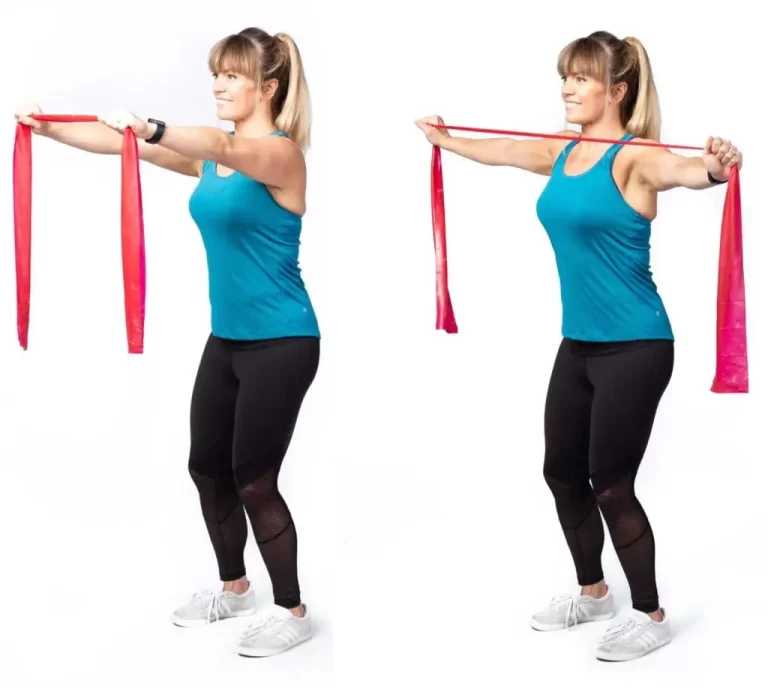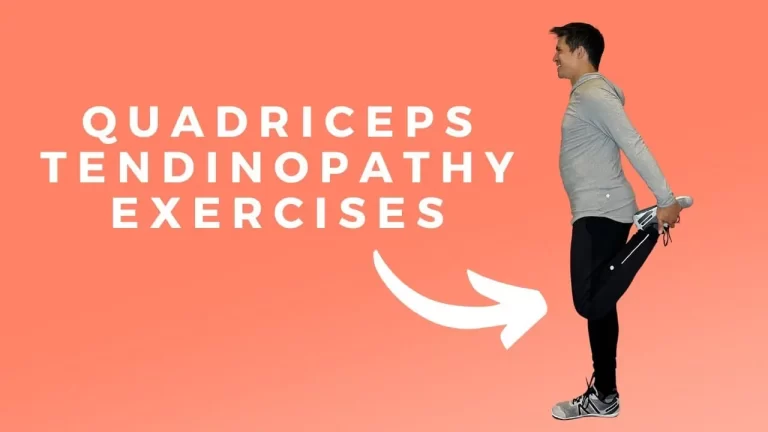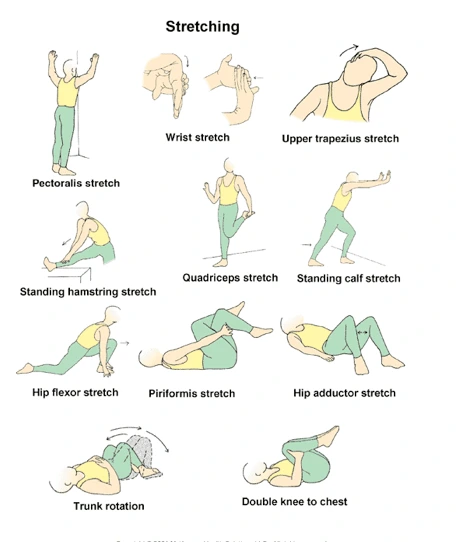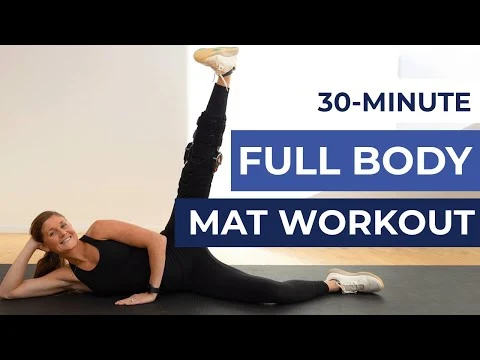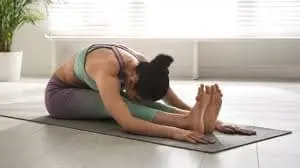20 Best Exercises For Ankle Pain
Introduction:
Ankle pain can result from Ankle sprains, overuse, arthritis, or limited mobility. Performing targeted exercises helps strengthen the ankle, improve flexibility, and reduce pain. These exercises are essential for faster recovery and injury prevention.
Bones, ligaments, tendons, and muscles form the complex ankle joint, which allows mobility and weight bearing. Walking, standing, and exercising may become difficult due to this pain, which could get worse if left untreated.
Particularly following an acute injury, get advice from a physician or physical therapist. Stay away from activities that increase your symptoms or create severe pain.
When doing Exercises For Ankle Pain, especially in the beginning, you should be mindful of how much pain you are experiencing. In the beginning, these workouts might make your symptoms a little worse. They should, however, become easier with time and may help in improving ankle mobility with consistent exercise.
Perform easy exercises to expand your ankle’s range of motion. You can get advice from a physical therapist about which ones are suitable.
Causes:
Numerous factors, from recent traumas to long-term illnesses, can contribute to ankle pain.
The most frequent reasons are listed as follows:
Sprains (most common)
- Most prevalent are sprains, which are caused by the straining or tearing of ligaments and frequently happen when the ankle rolls, twists, or turns awkwardly.
Tendon damage
- Inflammation of tendons, such as the Achilles or peroneal tendons, is known as tendinitis.
- Ruptures or tears in the tendon.
Ankle strain
- Excessive stretching can harm muscles or tendons.
Bursitis
- Inflammation of the fluid-filled sacs that act as a joint cushion.
Gout
- Usually begins in the big toe but can also affect the ankle, caused by the build-up of uric acid crystals.
Fractures
- Most prevalent are sprains, which are caused by the straining or tearing of ligaments and frequently happen when the ankle rolls, twists, or turns awkwardly.
Osteoarthritis
- Wear-and-tear arthritis is more prevalent in older people and those who have had injuries in the past.
Infection
- Pain, swelling, and redness are uncommon but possible side effects.
Rheumatoid arthritis
- Joint-related autoimmune disease.
Signs and symptoms:
Pain
- Dull, burning, throbbing, and sharp.
- While exercising, sleeping, or at night.
Bruising
- Skin discoloration.
- Often with muscular tears, fractures, or sprains.
Stiffness
- Reduced mobility.
- It is frequently worse in the morning or during rest periods (common in arthritis).
Tingling or numbness
- It may be a sign of tarsal tunnel syndrome or other nerve compression.
Increased swelling
- Could show up right once (sprain, fracture) or gradually (arthritis, overuse).
- Both localized and wide conditions in the foot and ankle are possible.
Weakness or Instability
- It feels as though the ankle could “give out.”
- Frequently as a result of past sprains or ligament damage.
A sound that pops or snaps
- Heard when the injury occurred.
- A tendon, ligament, or fracture might be the cause.
Unable to Support Weight
- Frequently observed in cases of severe sprains or fractures.
- Furthermore, it happens in cases of extreme pain or inflammation.
Warmth and Redness
- Might indicate gout, infection, or inflammation.
Deformity
- Unusual ankle posture or form.
- Points to a fracture or dislocation.
Advantages of Exercises For Ankle Pain:
Strengthens the Joints
- Increases the muscular, ligament, and tendon strength of the ankle.
- Prevents the ankle from giving out, particularly in cases of sprains.
- Lowers the chance of being hurt again.
Increases joint awareness, or proprioception.
- Through exercise, your body becomes more aware of how your ankles are positioned.
- Decreases the chance of additional injuries by enhancing balance and coordination.
Encourages Healing
- Enhances blood flow to the wounded tissue, helping in its recovery.
- Lessens swelling and persistent inflammation.
Avoids Prolonged Weakness or Stiffness
- The ankle may become weak or stiff if it is inactive.
- Frequent rehabilitation activities maintain the health of the joint and surrounding tissues.
Over Time, Pain Is Reduced
- Reducing tension in tense muscles and tendons is one way that mild stretching and strengthening might lessen pain.
- Restoring balance to the joint’s forces.
Helps in Preventing Further Injuries
- Strong and flexible ankles have a lower chance of:
- Strains and Sprains
- Tendonitis
- Beneficial for sportsmen and active people.
Restores range of motion.
- Ankle stiffness can be lessened by gently shifting it.
- Promotes healthy exercise habits and flexible joints.
How to figure out if the intensity of your workout is right for you:
Be mindful of the level of pain you feel when working out, especially when you’re initially starting. Your symptoms may initially improve as a result of these workouts. However, with consistent practice, they may help to improve shoulder movement and should get simpler with time.
This advice might help you decide whether the intensity of your workout is suitable. Additionally, it allows you to figure out the right degree of pain.
It might be helpful to rate your feelings on a scale of 0 to 10.10, where 10 represents the most painful event you have ever had. In this case, the following
- A score of 0–3 indicates minimal pain.
- 4 to 5 indicates bearable pain.
- A score of 6 to 10 indicates severe pain.
Pain during physical activity:
Keep the pain level between 0 and 5 at all times. You can alter the exercises if the pain reaches this point by:
- Slowing down a movement
- Increasing the amount of time spent sleeping in between tasks
- Reducing how often you do a movement
Pain following physical activity:
You shouldn’t have worsening shoulder aches with each workout. On the other hand, trying new workouts may cause short-term muscle soreness as the body gets used to the new movements. The pain you feel ought to go away quickly and not worsen if you exercise first thing in the morning.
Take these measures to think about before beginning an exercise program:
A few safety measures should be considered before beginning any fitness program in order to maximise the advantages. Take guidance from your doctor or physical therapist regarding the exercises that are most effective for your particular issue.
You should be mindful of your body and refrain from fighting pain. Pain during exercise is common, but if it persists or gets worse, it may be a sign that you’re pushing yourself too much. Begin with low-impact exercises and, after you can tolerate more pain, progressively advance to harder ones.
To avoid repeated injuries, it’s important to maintain proper form and technique. If you are unsure about how to successfully carry out an exercise regimen, get medical advice. Before beginning any activity, warm up to better prepare your muscles and joints.
Exercises For Ankle Pain:
For issues and pain in the ankles, feet, and toes, these exercises are beneficial.
Ankle pump
- You may extend your legs when you’re lying down.
- Make sure your feet are at rest.
- Then put your toes pointing straight ahead.
- Keeping your foot extended upward, pull your toes forward towards your shin.
- As a result, the front muscles in your lower leg should become more flexible.
- Hold this position for a few seconds.
- Be cautious and go slowly.
- Then return to your neutral position.
- Then relax.
- Repeat these exercises 5 to 10 times.
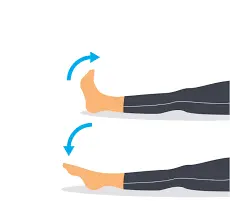
Ankle rotation
- First, settle into a chair.
- Raise the foot that is affected.
- Keep your leg straight and simply rotate your ankle.
- Carefully rotate your foot.
- Slowly in a clockwise direction.
- Rotate anticlockwise once 10 to 15 rings have been finished.
- Then return to your neutral position.
- Then relax.
- Repeat these exercises 5 to 10 times.
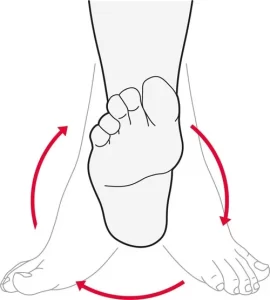
Towel Curls
- Sitting in the chair is the first step.
- Step on it after spreading the towel out.
- Increase the amount of cloth in front of your foot since the towel will be moving towards you.
- Maintaining a low heel, flex your foot back, and lift your toes.
- Reach out evenly in the middle of your foot and around the edges to get your foot as far out on the towel as you can while maintaining your heel on it.
- Pull the towel in toward you with your foot arch, keeping your heel straight.
- The more you extend and draw back the towel, the less you will need to move.
- Then return to your neutral position.
- Then relax.
- Repeat these exercises 5 to 10 times.

Standing Heel Raise
- The distance between both feet should be about hip-width.
- Make sure your weight is distributed equally over them.
- Putting your hands on your hips or, if necessary, holding to a strong object for support will help you maintain your balance.
- Do not bend or arch your back.
- Next, raise your heels off the floor.
- When lifting, keep your knees straight but not locked, and concentrate on using your calf muscles to help move yourself forward.
- Hold this position for a few seconds.
- As you carefully go down your heels to the floor, maintain control over your action and refrain from putting pressure.
- Then return to your neutral position.
- Then relax.
- Repeat these exercises 5 to 10 times.
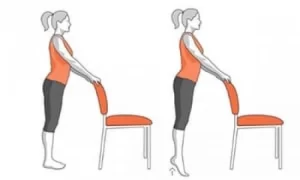
Seated Heel Raise
- Set your feet flat on the floor and sit down at a table that is strong.
- Next, concentrate on your calf muscles.
- Apply pressure to your foot.
- Put your heels up.
- Hold this position for a few seconds.
- Lower your heels.
- Then return to your neutral position.
- Then relax.
- Repeat these exercises 5 to 10 times.
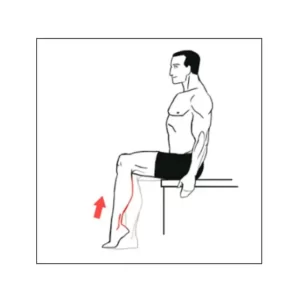
Ankle Alphabet
- Take a seat in a nice chair.
- Put out your leg.
- Next, form the letters of the alphabet in the air using your big toe.
- Proceed from point A to point Z one step at a time.
- Then return to your neutral position.
- Then relax.
- Repeat these exercises 5 to 10 times.
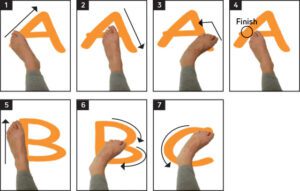
Marble pick up
- Sitting on a chair, place both feet on the floor in front of you.
- Put a few little marbles on the ground close to your feet so you can pick them up with your toes.
- A drinking cup or mug should be placed on the floor so that it is easily accessible on foot.
- Try out to use just your toes to lift the marbles.
- Try placing each stone in the mug or drinking cup after picking it up and holding it with your toes.
- Then return to your neutral position.
- Then relax.
- Repeat these exercises 5 to 10 times.
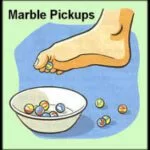
Seated Plantar Fascia Stretch
- Choose a comfortable chair and place your feet flat on the floor.
- Maintain a straight back and relaxed shoulders.
- Next, cross one knee with the other.
- In this way, you will be able to reach the bottom of your foot.
- Using the same side hand, grasp your toes to extend your foot.
- Carefully drawing your toes into your shin will lengthen the bottom of your foot.
- You should feel a stretch on the bottom of your foot, especially in the arch, as you move your toes closer to your shin.
- You might also feel it along your heel.
- Hold this position for a few seconds.
- Then return to your neutral position.
- Then relax.
- Repeat these exercises 5 to 10 times.
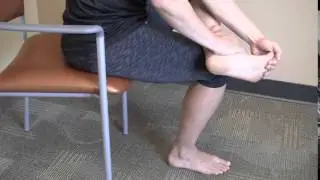
Standing Soleus muscle stretch
- Lean on a wall. Next, use both hands for support.
- As you take a step back around one to two feet, you should keep both feet flat on the floor.
- Keep your back heel on the ground and bend both knees.
- Stretch your lower calf by bending forward slowly, closer to the Achilles tendon.
- Hold this position for a few seconds.
- Then return to your neutral position.
- Then relax.
- Repeat these exercises 5 to 10 times.
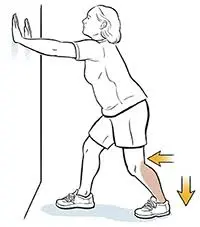
Golf ball roll
- Put yourself in the chair and begin to sit.
- Put a golf ball on the floor at your feet.
- Using as much pressure as feels comfortable, place one foot on the ball and move it around.
- After a minute or two, continue with the other foot.
- Then return to your neutral position.
- Then relax.
- Repeat these exercises 5 to 10 times.
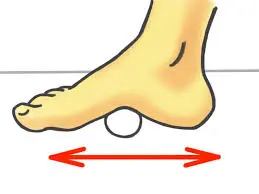
Bodyweight-Standing-Calf-Raise
- As much as you can, let your heels drop while keeping your foot bottoms on the raised edge of the surface.
- This was the beginning of the movement.
- Raise your heels as high as you can progressively.
- Hold this position for a few seconds.
- To get back to the starting posture, carefully lower your heels after pausing.
- Once you’ve reached the bottom, begin the next repetition.
- Then return to your neutral position.
- Then relax.
- Repeat these exercises 5 to 10 times.
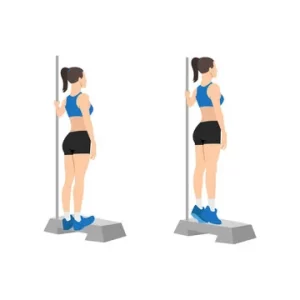
Standing calf stretch
- At arm’s length, place yourself in front of a wall.
- Make the right leg over the left.
- Touch the wall with both arms.
- Maintaining the front leg bent, straighten the back leg by pressing the left heel onto the floor.
- Hold this position for a few seconds.
- Then return to your neutral position.
- Then relax.
- Repeat these exercises 5 to 10 times.
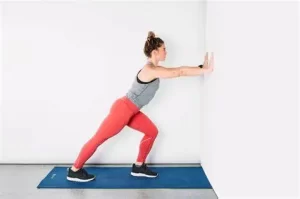
Toe raises
- Your feet should be hip-width apart.
- If you require assistance, rest against a wall or chair.
- Slowly lift your toes off the ground while maintaining your heels planted.
- At the top, hold this position for a few seconds and feel your shin muscles contract.
- Then return to your neutral position.
- Then relax.
- Repeat these exercises 5 to 10 times.
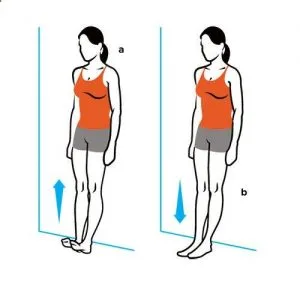
Toe splays
- Keep your feet flat on the ground.
- Without causing any strain, the toes should be as widely apart as possible.
- Hold this position for a few seconds.
- Then return to your neutral position.
- Then relax.
- Repeat these exercises 5 to 10 times.
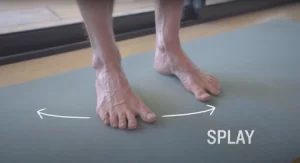
Toes on the Wall Stretch
- Start facing the wall with your toes on it.
- Lifting your toes causes the strain to get deeper.
- As you move, be certain that your heel stays strongly planted on the ground.
- The second leg should be behind you.
- Drop your heel.
- Maintain a forward stance.
- Hold this position for a few seconds.
- Then return to your neutral position.
- Then relax.
- Repeat these exercises 5 to 10 times.
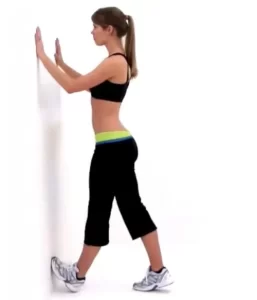
Single-Leg Balance
- Go ahead and stand on the ground.
- The foot can be moved back, and one leg can be bent at the knee.
- Then balance on your other foot.
- Hold this position for a few seconds.
- Put down the raised foot.
- Then return to your neutral position.
- Then relax.
- Repeat these exercises 5 to 10 times.
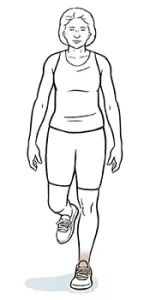
Resisted Plantarflexion
- Get started by sitting on the floor.
- Next, straighten the leg that is affected.
- The next step is to tie a resistance band around your foot’s heel.
- Press down on the two ends of the band with your hands.
- Point your toes forward slowly while applying pressure to the band’s resistance.
- Hold this position for a few seconds.
- Then return to your neutral position.
- Then relax.
- Repeat these exercises 5 to 10 times.
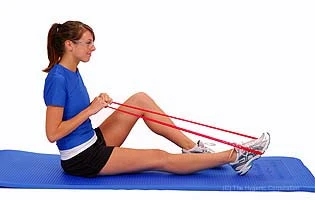
Resisted Dorsiflexion
- Take a seat on the ground. Following that, stretch the affected leg.
- Have someone hold the band or fasten the other end to something stable.
- Maintain a straight but relaxed knee position.
- Against the tension of the band, slowly raise your foot towards your shin.
- Hold this position for a few seconds.
- Then return to your neutral position.
- Then relax.
- Repeat these exercises 5 to 10 times.
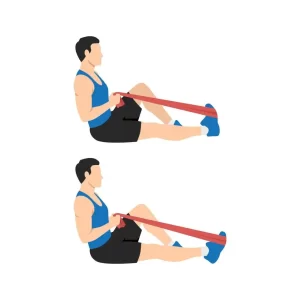
Towel stretch
- Sit down on the ground to start.
- Then extend your legs.
- Wrap one foot’s heel with a towel.
- Pull back until your calf starts to stretch while maintaining a straight knee.
- Hold this position for a few seconds.
- Then return to your neutral position.
- Then relax.
- Repeat with the other leg after switching.
- Repeat these exercises 5 to 10 times.
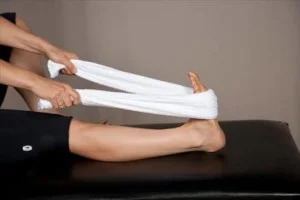
Tip-toe walking
- Select a flat, non-slip area to stand on.
- Place your right foot directly in front of your left so that the heel of your right foot touches the toes of your left.
- With caution, shift your weight forward onto your front foot.
- Step forward by placing your left foot heel to toe in front of your right.
- In a straight path, take 10 to fifteen steps, then turn around and walk back.
- If you need support, use a wall, counter, or other strong object.
- Then return to your neutral position.
- Then relax.
- Repeat these exercises 5 to 10 times.
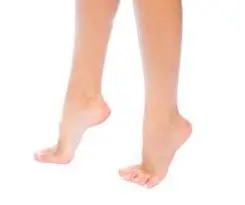
Exercise safety measures:
Only after speaking with a doctor or physical therapist should you begin exercising for ankle pain. It’s essential to engage in safe, suitable exercises that take your particular situation into consideration.
First, get correct advice.
- To determine the reason for your ankle pain, always get medical advice from a physician or physical therapist.
- This guarantees that you’re avoiding dangerous workouts and selecting suitable ones.
Wait until the severe pain or swelling goes away.
- Avoid weight-bearing or range-of-motion exercises during the first 24 to 72 hours after an acute injury.
- When dealing with sprains or other severe injuries, start with R.I.C.E.
Before you begin, warm up.
- Before stretching or strengthening, engage in a gentle exercise to improve blood circulation.
- Don’t go right into an intense workout.
Stay away from painful movements.
- If a workout results in increasing, acute, or shooting pain, stop right away.
- Pain is a warning indication, although mild pain is ok.
Put on the Proper Shoes
- Ankle joint tension can be lessened with the use of supportive, cushioned footwear.
- Unless a therapist instructs you otherwise, avoid doing barefoot workouts on hard or uneven surfaces.
Make Careful Use of Resistance Bands
- First, pick light resistance.
- Securely fasten the band while maintaining control over the movement.
Make progress gradually.
- Stretching, strengthening, and balancing exercises should come after some mild range-of-motion activities.
- A doctor’s approval is required before returning to high-impact sports or hobbies.
Pay attention to control and balance.
- When performing balancing exercises, choose an even surface.
- If you require help, hold on to a wall or chair.
Stretch gently and slowly.
- Do not overstretch or jump.
- For a few seconds, maintain each stretch without pushing the workout.
When did you stop performing this workout?
You Feel Sudden or Severe Pain
- This can suggest that excessive working should end right now and that you should relax.
An increase in swelling or bruises
- Even while some swelling is typical, it should be concerning if it gets worse, especially after several sessions.
- Possible causes include inflammation, abuse, or abnormal development.
Reduction of the range of motion or strength when exercising.
- A strain or re-injury may be indicated by a sudden weakness or stiffness in your ankle or foot.
Chronic Pain Following Exercise
- You’ve probably overworked yourself if you experience pain, stiffness, or swelling following a session that lasts more than a day or two.
- Lower the intensity or go back to a level that is safer.
A feeling of numbness or tingling
- This might lead to decreased blood flow or nerve involvement, both of which require medical care.
Weakness or Stability Loss
- If your ankle breaks out, feels weak, or is unstable, stop to prevent further damage.
- Put on ice, take a break, and stop exercising if you experience any of these symptoms.
Not Able to Support the Weight
- This might mean that the tear has become worse or that there is significant inflammation.
- Instead of becoming better with time, pain grows worse.
- Indicates a possible misunderstanding or a poor response to the current treatment.
You’re worn out or unmotivated because of your persistent pain.
- Pain-related tiredness may make it more difficult to remain consistent with therapy and increase your risk of making mistakes.
Which workouts should you avoid doing if you have ankle pain?
To prevent more injuries, lessen joint stress, and encourage recovery, it’s essential to adjust your exercise regimen if you’re having ankle pain.
Activities with a High Impact
- These put excessive stress on the ankle joint and may lead to sprains, inflammation, and other conditions.
- Jogging or running.
- Exercises involving jumping, such as burpees, box jumps, and jump squats
- HIIT exercises that require a lot of jumping or sideways movement
Strength Training for the Lower Body with Heavy Weights
- The ankle joint may be overloaded by some strength exercises, particularly if form is restricted by pain.
- Squats with a barbell
- Lunges
- Deadlifts
- Lifting large weights while standing
Specific Pilates or Yoga Movements
- The ankle is strained by some yoga and pilates poses and motions, especially those that involve plantarflexion (toes pointed) or dorsiflexion (toes curved upward).
- Downward dog
- Warrior poses
- Chair pose
Sports with Quick Changes of Direction or Contact
- Sports involving fast turns or contact can make ankle problems worse.
- Rugby
- Football
- Soccer
- Tennis
- Volleyball
Lifestyle Modifications to Reduce Ankle Pain:
Ankle pain that is persistent or recurrent often requires more than just rest and medicine. Your everyday routine, what you wear, how you exercise, and how you take care of your health can either positively or negatively impact your recovery.
These lifestyle changes are intended to support long-term ankle health, lessen ankle stress, and improve joint function.
Keep Your Weight in Check
Every step you take while carrying too much weight puts more strain on your ankles.
- When walking, the strain on the ankle increases with each pound of body weight.
- Reduced inflammation and improved mobility are two benefits of weight loss.
Select supportive footwear
One of the main causes of ankle pain is insufficient footwear.
- Put on footwear that supports the arch, has cushioning, and a solid heel.
- For everyday wear, stay away from flip-flops and high heels.
- Old shoes should be replaced regularly.
- For additional support, especially if you have high arches or flat feet, think about getting orthotic inserts.
Wear support or ankle braces as necessary.
If you feel unstable at the ankle:
- When working out, use tape, an ankle brace, or a compression sleeve.
- Wearing braces can help avoid rolling and excessive movement when playing sports or recovering from injuries.
Regularly stretch and strengthen.
Frequent workouts to improve ankle mobility, strength, and balance can:
- Increase the stability of your joints.
- Lower the chance of re-injury
- Reduce stiffness
Avoid standing or walking for a lengthy period of time.
Ankle pain can be made worse by standing for extended periods of time.
- Sit and raise your ankle sometimes.
- If you can’t avoid standing at work, use a footrest or stool.
- If your profession demands you to walk for extended periods of time, use cushioned insoles.
Make recovery and rest a priority.
The severity of ankle issues might be increased by overworking or by ignoring early symptoms.
Give your ankles time to heal:
- Get a good night’s rest.
- Refrain from ignoring pain.
- Plan days off in between intense workouts.
Continue to go to Rehab Regularly.
- Continue doing your physical therapy exercises even after the pain goes away if you have an ankle injury.
- Recurrent injuries result from many people stopping too soon.
When to Consult a Physician:
If, after doing exercises at home, your ankle pain doesn’t go away after a few weeks, or if you suffer from:
- Extreme bruising or swelling
- Unable to support the weight
- Feeling numb or tingling
- Pain that gets worse when you move
At such a point, a medical expert should be consulted for a detailed evaluation.
Summary:
Many conditions, such as sprains, arthritis, overuse, or improper footwear, can cause ankle pain. Targeted, moderate exercises can help strengthen the joint, increase mobility, and lessen pain, whether you’re healing from an injury or have chronic pain.
Ankle exercises can help reduce pain, regain function, and avoid more issues if done consistently and carefully. Pay attention to your body, start out slowly, and stay committed to your rehabilitation.
Combine these exercises with a healthy lifestyle and professional advice as necessary for the best results. Developing an ankle-friendly lifestyle is more important for reducing ankle pain than using isolated treatments. Every small adjustment, from your shoes to your food and regular exercise routine, helps to provide long-lasting relief and protection.
The best protection against injury is having joints and muscles that are flexible and strong enough to endure strain. Some activities can help ease some pain episodes in basic situations involving ankle pain. Never engage in any workout that worsens your pain, always remember.
FAQ:
What is causing the ankle pain?
Sprains (the most common cause)
Fractures
Tendonitis
Achilles tendon injuries
Gout
Overuse or poor footwear
Is it better to rest or work out my painful ankle?
Depending on the cause, yes.
Gentle stretching and strengthening exercises are advised to restore function once the inflammation is gone.
If I have ankle pain, can I still walk?
If there is not a significant injury and the pain is not severe, limited walking with support or a brace may be allowed. However, it’s advisable to rest and see a doctor if walking makes the pain worse or results in limping.
Which shoes are good for people who have ankle pain?
Shoes that provide support with:
Strong arch support
Strong heel counter for absorbing shock
A wide toe box
Ankle pressure may also be lessened with the use of orthotic insoles.
Can someone with ankle arthritis exercise?
Yes, low-impact workouts like cycling, swimming, and stretching for ankle mobility can be beneficial. Unless instructed by a physician or physical therapist, stay away from twisting or high-impact exercises.
If my ankle pain persists, are exercises safe to do?
Yes, but continue with caution. Mild range-of-motion and strengthening activities can be helpful if the pain is not caused by a recent acute injury. Exercise should be avoided, though, if you have extreme swelling, intense pain, or trouble bearing weight.
Which exercises are most effective for treating ankle pain?
Ankle pump
Ankle rotation
Standing calf stretch
Calf raise
Toe raise
Heel raise
Towel stretch
How frequently should I perform exercises for ankle pain?
Usually, once or twice a day, depending on how bad your pain is and how you’re feeling generally. Increase as tolerated after starting with one set of ten repetitions.
What happens if my ankle hurts worse after the exercises?
Stop right away if:
During or after exercise, pain is worse.
Increased swelling
You experience weakness or instability.
To change your regimen, speak with a doctor or physical therapist.
Does recovering from ankle pain need balance training?
Indeed. Exercises for balance, such as using a balance board or balancing on one foot, are beneficial.
Strengthen your muscles that provide stability.
Learn more about your sense of balance, or joint position.
Prevent sprains in the future.
References:
- Five Ankle Pain-Reduction Exercises | Fort Worth Bone & Joint Clinic, n.d. Foot-exercises.html—https://thcboneandjoint.com/educational-resources
- On February 7, 2025, NHS informs. Activities that alleviate ankle discomfort The NHS provides information. www.nhsinform.scot/illnesses-and-conditions/muscle-bone-and-joints/leg-and-foot-problems-and-conditions/ankle-pain-exercises NHS Inform
- A. Marcin. July 13, 2017. Try these eight stretches for your ankles. https://www.healthline.com/health/fitness-exercise/ankle-stretches in Healthline
- OrthoInfo, AAOS, foot and ankle conditioning program (n.d.). The website https://orthoinfo.aaos.org/en/recovery/ has the foot-and-ankle conditioning program details.
- Exercises for patients after surgery or an acute ankle injury (n.d.). Cambridge University Hospitals. Exercises for patients after an acute ankle injury or operation can be found at https://www.cuh.nhs.uk/patient-information/
- L., DO. Inverarity, May 18, 2024. exercises to strengthen the ankles for ankle-related conditions. Excellent Health. Ankle exercises: a comprehensive guide (https://www.verywellhealth.com/) 2696480
- S. Physio, n.d.-d. Surrey Physio’s Top 5 Exercises for Persistent Ankle Pain. Surrey Physio. Here are the top 5 exercises for chronic ankle pain: https://www.surreyphysio.co.uk/top-5/best-5-exercises/

